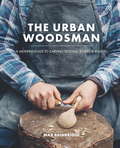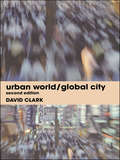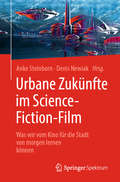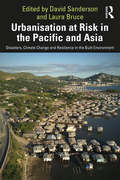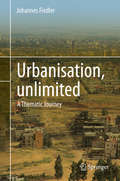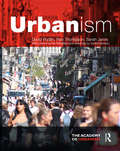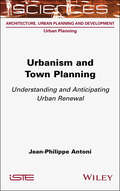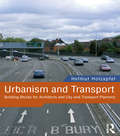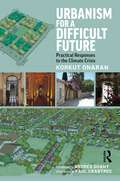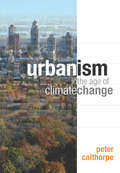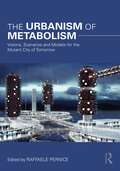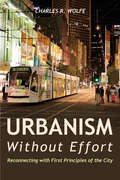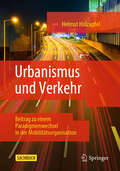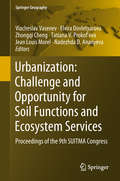- Table View
- List View
The Urban Woodsman
by Max BainbridgeHand carving is easy, satisfying and therapeutic when guided by Max Bainbridge. Create your own unique pieces and carve with confidence thanks to detailed information on tools, cutting techniques and clear step-by-step photography accompanying each project. Start with basic spoons, cooking spoons and spatulas, before moving onto butter knives, chopping boards and small bowls, with only a few simple tools required. Max also advises on the perfect finish for your projects - how to sand, ebonise, scorch and texture surfaces as well as waxing and oiling your new creations. Whether you are a novice or an experienced carver, this book will inspire you to make something that you will be proud of.
Urban World/Global City
by David ClarkThis book identifies and accounts for the characteristics of the contemporary city and of urban society. It analyzes the distribution and growth of settlements and explores the social and behavioral characteristics of urban living. The latest theoretical and empirical developments and insights are synthesized and presented in an accessible and engaging way.This second edition has been extensively updated and referenced. Each chapter includes sets of learning objectives, annotated readings and topics for discussion. Well-illustrated throughout, it will be essential reading for students of geography, sociology and development studies and all who seek an understanding of how the urban world has evolved and how it will change in the twenty-first century.
Urban World/Global City
by David ClarkThis book identifies and accounts for the characteristics of the contemporary city and of urban society. It analyzes the distribution and growth of settlements and explores the social and behavioral characteristics of urban living. The latest theoretical and empirical developments and insights are synthesized and presented in an accessible and engaging way.This second edition has been extensively updated and referenced. Each chapter includes sets of learning objectives, annotated readings and topics for discussion. Well-illustrated throughout, it will be essential reading for students of geography, sociology and development studies and all who seek an understanding of how the urban world has evolved and how it will change in the twenty-first century.
Urbane Zukünfte im Science-Fiction-Film: Was wir vom Kino für die Stadt von morgen lernen können
by Ferdinando TerelleDieses Buch bietet eine außergewöhnliche Perspektive auf die nachhaltige, lebenswerte und humane Gestaltung urbaner Zukünfte, indem es sich dieser Herausforderung mit Blick auf das Science-Fiction-Kino sowie mit Bezügen zu Literatur, Architektur und Design nähert.Schon im Jahr 2050 sollen mehr als zwei Drittel aller Menschen in Ballungsräumen leben. Doch Großstädte laufen bereits heute Gefahr, an ihre Leistungsgrenzen zu stoßen: In den Megacities drohen Überbevölkerung, Verkehrschaos, Luftverschmutzung und Vereinsamung. Auf welche Weise werden solche zukünftig immer drängenderen Probleme in den fiktionalen Welten von Genreklassikern und aktuellen Blockbustern gelöst? Was lässt sich aus den fantastischen Zukunftsentwürfen zur Bewältigung urbaner Herausforderungen lernen?mediale und nachhaltige Großstadt-Architekturen New-Work-Designs und -KonzepteStrategien gegen gesellschaftliche SpaltungZu diesen und anderen Themen zeigen die Autoren eine Vielzahl von Ideen für die Stadtplanung der Zukunft auf und plädieren für das Nutzbarmachen kreativer Potenziale bei der Gestaltung lebenswerter Umgebungen.
Urbanisation at Risk in the Pacific and Asia: Disasters, Climate Change and Resilience in the Built Environment
by David Sanderson Laura BruceThis book presents practical approaches for tackling the threats from climate change and disasters to urban growth in Pacific island countries and Asian nations. With chapters written by leading scholars and practitioners, Urbanisation at Risk presents research and case studies from island countries across the Pacific, Cambodia, Nepal and the Philippines. The book explores and presents the theory, policy and practice of how governments, civil society, aid organisations and people themselves prepare for, withstand and recover better from urban disasters including windstorms, floods, earthquakes and fires, and the effects of climate change. This book is written for urban policy makers, researchers, humanitarian aid and development workers, and anyone interested in urbanisation, participatory approaches, disasters, resilience and climate change adaptation.
Urbanisation at Risk in the Pacific and Asia: Disasters, Climate Change and Resilience in the Built Environment
by David Sanderson Laura BruceThis book presents practical approaches for tackling the threats from climate change and disasters to urban growth in Pacific island countries and Asian nations. With chapters written by leading scholars and practitioners, Urbanisation at Risk presents research and case studies from island countries across the Pacific, Cambodia, Nepal and the Philippines. The book explores and presents the theory, policy and practice of how governments, civil society, aid organisations and people themselves prepare for, withstand and recover better from urban disasters including windstorms, floods, earthquakes and fires, and the effects of climate change. This book is written for urban policy makers, researchers, humanitarian aid and development workers, and anyone interested in urbanisation, participatory approaches, disasters, resilience and climate change adaptation.
Urbanisation, unlimited: A Thematic Journey
by Johannes FiedlerIn a series of essays, the process of urbanisation – a human mega-trend acquiring unprecedented scale and speed as globalisation proceeds – is examined in the most diverse contexts and stages of development. Drawing on scientific references and identifying recurring themes like dispersion, privatisation and vitality, Fiedler devises the glossary for a cross-cultural understanding of the global urban system emerging. Images and anecdotal evidence reconnect these themes to local realities. The tone of the essays conveys a post-voluntarist attitude, derived from many years of professional experience – critical of both neoliberal practices and determinist ideas.To “condemn the reality” of global urbanization “is fruitless”, writes Johannes Fiedler in this unlimited view of a world of constant motion, subject no longer to just its planetary rotations, but also to the constant push and pull of its various populations, some of whose giant constructions shift the earth’s axis.From the foreword by Lars Lerup
Urbanism
by Sarah Jarvis Rob Thompson David RudlinThe Academy of Urbanism was founded in 2006 with a mission to recognise, encourage and celebrate great places across the UK, Europe and beyond, and the people and organisations that create and sustain them. This book is a compendium of seventy five places that have been shortlisted as part of the Academy's annual awards scheme which covers great Places, Streets, Neighbourhoods, Towns and Cities. Included are 75 places shortlisted between 2009 and 2013. Each has been visited by a team of Academicians who have spent time in the place, talked to officials and local people and sought to understand what it is that makes them special and how they have achieved what they have achieved. The Academy also commissions a poem, a drawing and a figure ground plan to understand and interpret the place. David Rudlin, Rob Thompson and Sarah Jarvis have drawn on this treasure trove of material to tell the story of these 75 places. In doing so they have created the most comprehensive compendium of great urban places to have been published for many years.
Urbanism
by Sarah Jarvis Rob Thompson David RudlinThe Academy of Urbanism was founded in 2006 with a mission to recognise, encourage and celebrate great places across the UK, Europe and beyond, and the people and organisations that create and sustain them. This book is a compendium of seventy five places that have been shortlisted as part of the Academy's annual awards scheme which covers great Places, Streets, Neighbourhoods, Towns and Cities. Included are 75 places shortlisted between 2009 and 2013. Each has been visited by a team of Academicians who have spent time in the place, talked to officials and local people and sought to understand what it is that makes them special and how they have achieved what they have achieved. The Academy also commissions a poem, a drawing and a figure ground plan to understand and interpret the place. David Rudlin, Rob Thompson and Sarah Jarvis have drawn on this treasure trove of material to tell the story of these 75 places. In doing so they have created the most comprehensive compendium of great urban places to have been published for many years.
Urbanism and Town Planning: Understanding and Anticipating Urban Renewal
by Jean-Philippe AntoniSustainable urban planning and urban renewal are major challenges of the 21st century. In this context, Urbanism and Town Planning proposes a geohistorical approach to urban construction. The city and its neighborhoods are studied through their materials and general layout, which sometimes reveal a logic of economic profitability, prestige and social equity, and sometimes a more innovative approach from an environmental perspective. Across these elements, unbuilt spaces (distinctive streets and squares) and built spaces (commercial and residential areas, both individual and collective) form a three-dimensional grid of “voids” and “solids”, characteristic of urban landscapes and lifestyles. Supported by numerous original examples, this book is a comprehensive summary of the most tangible elements of urban planning and development; elements that must be put into context in order to think concretely about the development of the cities of the future.
Urbanism and Town Planning: Understanding and Anticipating Urban Renewal
by Jean-Philippe AntoniSustainable urban planning and urban renewal are major challenges of the 21st century. In this context, Urbanism and Town Planning proposes a geohistorical approach to urban construction. The city and its neighborhoods are studied through their materials and general layout, which sometimes reveal a logic of economic profitability, prestige and social equity, and sometimes a more innovative approach from an environmental perspective. Across these elements, unbuilt spaces (distinctive streets and squares) and built spaces (commercial and residential areas, both individual and collective) form a three-dimensional grid of “voids” and “solids”, characteristic of urban landscapes and lifestyles. Supported by numerous original examples, this book is a comprehensive summary of the most tangible elements of urban planning and development; elements that must be put into context in order to think concretely about the development of the cities of the future.
Urbanism and Transport: Building Blocks for Architects and City and Transport Planners
by Helmut HolzapfelHelmut Holzapfel’s Urbanism and Transport, a bestseller in its own country, now available in English, examines the history and the future of urban design for transport in major European cities. Urbanism and Transport shows how the automobile has come to dominate the urban landscape of cities throughout the world, providing thought-provoking analysis of the societal and ideological precursors that have given rise to these developments. It describes the transformation that occurred in urban life through the ongoing separation of social functions that began in the 1920s and has continued to produce today's phenomenon of fractured urban experience – a sort of island urbanism. Professor Holzapfel examines the vital relation between the house and the street in the urban environment and explains the importance of small-scale, mixed-use urban development for humane city living, contrasting such developments with the overpowering role that the automobile typically plays in today's cities. Taking the insights gained from its historical analysis with a special focus on Germany and the rise of fascism, the book provides recommendations for architects and engineers on how urban spaces, streets, structures and transport networks can be more successfully integrated in the present day. Urbanism and Transport is a key resource for architects, transport engineers, urban and spatial planners, and students providing essential basic knowledge about the urban situation and the challenges of reclaiming cities to serve the basic needs of people rather than the imperatives of automobile transport.
Urbanism and Transport: Building Blocks for Architects and City and Transport Planners
by Helmut HolzapfelHelmut Holzapfel’s Urbanism and Transport, a bestseller in its own country, now available in English, examines the history and the future of urban design for transport in major European cities. Urbanism and Transport shows how the automobile has come to dominate the urban landscape of cities throughout the world, providing thought-provoking analysis of the societal and ideological precursors that have given rise to these developments. It describes the transformation that occurred in urban life through the ongoing separation of social functions that began in the 1920s and has continued to produce today's phenomenon of fractured urban experience – a sort of island urbanism. Professor Holzapfel examines the vital relation between the house and the street in the urban environment and explains the importance of small-scale, mixed-use urban development for humane city living, contrasting such developments with the overpowering role that the automobile typically plays in today's cities. Taking the insights gained from its historical analysis with a special focus on Germany and the rise of fascism, the book provides recommendations for architects and engineers on how urban spaces, streets, structures and transport networks can be more successfully integrated in the present day. Urbanism and Transport is a key resource for architects, transport engineers, urban and spatial planners, and students providing essential basic knowledge about the urban situation and the challenges of reclaiming cities to serve the basic needs of people rather than the imperatives of automobile transport.
Urbanism for a Difficult Future: Practical Responses to the Climate Crisis
by Korkut OnaranUrbanism for a Difficult Future: Practical Responses to the Climate Crisis is a much-needed guide to launching the next generation of land use planning and urbanism that will enable us to adapt to and survive the consequences of climate change. The book offers strong, straightforward measures for creating a landscape of resilience via pockets of self-sufficiencies. It demonstrates how to secure systems that sustain life (energy, water, food, waste, and production of essential goods) as well as political and social protocols enabling agile decision-making in managing these systems effectively at local levels. It also provides the design principles for creating a built environment that will enable the kind of localization we need for adaptation. The book explores how it is possible to create a life that does not depend on large-scale regional sustenance systems which are likely to be disrupted or fail. This book uncovers how to enable people to be creative, productive, and supportive at local levels, so that we can achieve strong and diverse local economies that can sustain life. It will appeal to students, planners, and policy makers working in environmental studies, environmental engineering, urban and regional planning, architecture, landscape architecture, and urbanism.
Urbanism for a Difficult Future: Practical Responses to the Climate Crisis
by Korkut OnaranUrbanism for a Difficult Future: Practical Responses to the Climate Crisis is a much-needed guide to launching the next generation of land use planning and urbanism that will enable us to adapt to and survive the consequences of climate change. The book offers strong, straightforward measures for creating a landscape of resilience via pockets of self-sufficiencies. It demonstrates how to secure systems that sustain life (energy, water, food, waste, and production of essential goods) as well as political and social protocols enabling agile decision-making in managing these systems effectively at local levels. It also provides the design principles for creating a built environment that will enable the kind of localization we need for adaptation. The book explores how it is possible to create a life that does not depend on large-scale regional sustenance systems which are likely to be disrupted or fail. This book uncovers how to enable people to be creative, productive, and supportive at local levels, so that we can achieve strong and diverse local economies that can sustain life. It will appeal to students, planners, and policy makers working in environmental studies, environmental engineering, urban and regional planning, architecture, landscape architecture, and urbanism.
Urbanism in the Age of Climate Change
by Peter CalthorpeAccording to Urbanism in the Age of Climate Change, relentless and thoughtless development have created a way of living that brings us to a point of reckoning regarding energy, climate change and the way we shape our communities. The answer to these crises is Sustainable Development, a thoughtful combination of good Urbanism with renewable energy sources, state of the art conservation techniques, new green technologies, and integrated services and utilities. Sustainable Urbanism, the most recent result of Peter Calthorpe’s forward thinking, provides all the inherent benefits of Urbanism amplified by a new generation of ecological design, smart grids, climate responsive buildings, electric cars, and next-generation transit systems. This clearly written and beautifully designed book is an exploration of the challenges and potential shifts in our culture, economy, and environment and the ways they can affect the future of our communities.
The Urbanism of Metabolism: Visions, Scenarios and Models for the Mutant City of Tomorrow
by Raffaele PerniceThis edited book explores and promotes reflection on how the lessons of Metabolism experience can inform current debate on city making and future practice in architectural design and urban planning. More than sixty years after the Metabolist manifesto was published, the author’s original contributions highlight the persistent links between present and past that can help to re-imagine new urban futures as well as the design of innovative intra-urban relationships and spaces. The essays are written by experienced scholars and renowned academics from Japan, Australia, Europe, South Korea and the United States and expose Metabolism’s special merits in promoting new urban models and evaluate the current legacy of its architectural projects and urban design lessons. They offer a critical, intellectual, and up-to-date account of the Metabolism projects and ideas with regard to the current evolution of architectural and urbanism discourse in a global context. The collection of cross-disciplinary contributions in this volume will be of great interest to architects, architectural and urban historians, as well as academics, scholars and students in built environment disciplines and Japanese cultural studies.
The Urbanism of Metabolism: Visions, Scenarios and Models for the Mutant City of Tomorrow
by Raffaele PerniceThis edited book explores and promotes reflection on how the lessons of Metabolism experience can inform current debate on city making and future practice in architectural design and urban planning. More than sixty years after the Metabolist manifesto was published, the author’s original contributions highlight the persistent links between present and past that can help to re-imagine new urban futures as well as the design of innovative intra-urban relationships and spaces. The essays are written by experienced scholars and renowned academics from Japan, Australia, Europe, South Korea and the United States and expose Metabolism’s special merits in promoting new urban models and evaluate the current legacy of its architectural projects and urban design lessons. They offer a critical, intellectual, and up-to-date account of the Metabolism projects and ideas with regard to the current evolution of architectural and urbanism discourse in a global context. The collection of cross-disciplinary contributions in this volume will be of great interest to architects, architectural and urban historians, as well as academics, scholars and students in built environment disciplines and Japanese cultural studies.
Urbanism Without Effort: Reconnecting with First Principles of the City (Island Press E-ssentials Ser.)
by Charles R. WolfeHow do you create inviting and authentic urban environments where people feel at home? Countless community engagement workshops, studies by consulting firms, and downtown revitalization campaigns have attempted to answer this age-old question. In Urbanism Without Effort, Chuck Wolfe argues that “unplanned” places can often teach us more about great placemaking than planned ones. From impromptu movie nights in a Seattle alley to the adapted reuse of Diocletian’s Palace in Split, Croatia, Wolfe searches for the “first principles” of what makes humans feel happy and safe amid the hustle and bustle of urban life. He highlights the common elements of cities around the world that spontaneously bring people together: being inherently walkable, factors that contribute to safety at night, the importance of intersections and corners, and more. In this age of skyrocketing metropolitan growth, he argues, looking to the past might be our best approach to creating the urban future we dream about. A whirlwind global tour, Urbanism Without Effort offers readers inspiration, historical context, and a better understanding of how an inviting urban environment is created.
Urbanismus und Verkehr: Bausteine für Architekten, Stadt- und Verkehrsplaner
by Helmut HolzapfelDas Buch gibt einen interdisziplinär aufgebauten Überblick der Zusammenhänge zwischen Stadt/Raumentwicklung und Verkehr. Methodisch hat es einen historisch gegliederten Aufbau und gibt damit auch einen Einblick in die Geschichte von Verkehr und Urbanität. Den "Spirit" und Schwung bezieht das Buch aus seiner kritischen und - teilweise neuen - interdisziplinären Perspektive. Dadurch werden bisher selten thematisierte - und auch für Architekten interessante - Einblicke in Wechselwirkung von Stadtgestaltung/Kommunikation und Verkehr möglich.Die 2. Auflage wurde durchgesehen und ergänzt durch die Kapitel „Mobilitätszukunft: Bewusstseinswandel oder Technik“ und „Der Hype um die Mobilität“. Die Bedeutung dieses Buches nicht nur für die Ausbildung und die Fachwelt, sondern auch für Bürgerinitiativen und Umweltorganisationen wird weiter deutlich hervorgehoben in einem Vorwort von Wolfgang Lohbeck von Greenpeace Deutschland.
Urbanismus und Verkehr: Beitrag zu einem Paradigmenwechsel in der Mobilitätsorganisation
by Helmut HolzapfelDas Sachbuch, jetzt in der dritten erneut überarbeiteten Auflage beinahe schon ein Klassiker der interdisziplinär begriffenen Verkehrs- und Stadtforschung, ist aktueller denn je. Es vermittelt auf kluge Weise Kenntnisse, der historischen und sozio-kulturellen Wurzeln einer einseitig vom Automobil dominierten Perspektive der Verkehrsplanung. Es zeigt die Entwicklung einer von fossiler Energie getriebenen Planung, die seit Jahrzehnten die sozialen und ökologischen Systeme überfordert, und vermittelt darüber hinaus Lösungsansätze, für eine menschengerechtere Stadt- und Verkehrsorganisation, die nicht ihr Heil in der Distanzüberwindung findet, sondern Qualität in der Nähe. Das völlig neu konzipierte Schlusskapitel zeigt eindringlich, dass der Wandel in Transport und Verkehr, oft als Verkehrswende bezeichnet, ohne einen radikalen Paradigmenwechsel in Verhalten, Städtebau und Mobilitätsorganisation nicht gelingen kann. Die 3. Auflage wird mit einem Vorwort von Jens Hilgenberg, Bund für Umwelt und Naturschutz Deutschland e.V. (BUND), eingeleitet.
Urbanismus und Verkehr
by Helmut HolzapfelDas Buch gibt einen interdisziplinär aufgebauten Überblick der Zusammenhänge zwischen Stadt/Raumentwicklung und Verkehr. Methodisch hat es einen historisch gegliederten Aufbau und gibt damit auch einen Einblick in die Geschichte von Verkehr und Urbanität. Den "spirit" und Schwung bezieht das Buch aus seiner kritischen und - teilweise neuen - interdiziplinären Perspektive. Dadurch werden bisher selten thematisierte - und auch für Architekten interessante -Einblicke in Wechselwirkung von Stadtgestaltung/Kommunikation und Verkehr möglich.Die Argumentation des Buches bewegt sich zwischen einer technischen, kulturhistorischen und sozialwissenschaftlichen Sichtweise und ist daher ungewöhnlich. Einige Bilder geben eine Vorstellung zeitspezifischer Sichtweisen auf Transport und Stadtentwicklung.
Urbanization: Proceedings of the 9th SUITMA Congress (Springer Geography)
by Viacheslav Vasenev Elvira Dovletyarova Zhongqi Cheng Tatiana V. Prokof’eva Jean Louis Morel Nadezhda D. AnanyevaThis proceedings volume focuses on different aspects of environmental assessment, monitoring, and management of urban and technogenic soils. Soils of Urban, Industrial, Traffic, Mining and Military Areas (SUITMAs) differ substantially from their natural zonal counterparts in their physical, chemical and biological features, their performed functions, and supported services.This book discusses the monitoring, analysis and assessment of the effects of urbanization on soil functions and services. Further, it helps to find solutions to the environmental consequences of urbanization and discusses best management practices such as management and design of urban green infrastructure, waste management, water purification, and reclamation and remediation of contaminated soils in the context of sustainable urban development.The book includes thematic sections corresponding to 14 sessions of the SUITMA 9 congress, covering broad topics that highlight the importance of urban soils for society and environment and summarizing the lessons learned and existing methodologies in analyses, assessments, and modeling of anthropogenic effects on soils and the related ecological risks.This proceedings book appeals to scientists and students as well as practitioners in soil and environmental science, urban planning, geography and related disciplines, and provides useful information for policy makers and other stakeholders working in urban management and greenery.
Urbanization and Contemporary Chinese Art (Routledge Advances in Art and Visual Studies)
by Meiqin WangThis book explores the relationship between the ongoing urbanization in China and the production of contemporary Chinese art since the beginning of the twenty-first century. Wang provides a detailed analysis of artworks and methodologies of art-making from eight contemporary artists who employ a wide range of mediums, including painting, sculpture, photography, installation, video, and performance. She also sheds light on the relationship between these artists and their sociocultural origins, investigating their provocative responses to various processes and problems brought about by Chinese urbanization. With this urbanization comes a fundamental shift of the philosophical and aesthetic foundations in the practice of Chinese art: from a strong affiliation with nature and countryside to one that is complexly associated with the city and the urban world.
Urbanization and Contemporary Chinese Art (Routledge Advances in Art and Visual Studies)
by Meiqin WangThis book explores the relationship between the ongoing urbanization in China and the production of contemporary Chinese art since the beginning of the twenty-first century. Wang provides a detailed analysis of artworks and methodologies of art-making from eight contemporary artists who employ a wide range of mediums, including painting, sculpture, photography, installation, video, and performance. She also sheds light on the relationship between these artists and their sociocultural origins, investigating their provocative responses to various processes and problems brought about by Chinese urbanization. With this urbanization comes a fundamental shift of the philosophical and aesthetic foundations in the practice of Chinese art: from a strong affiliation with nature and countryside to one that is complexly associated with the city and the urban world.
